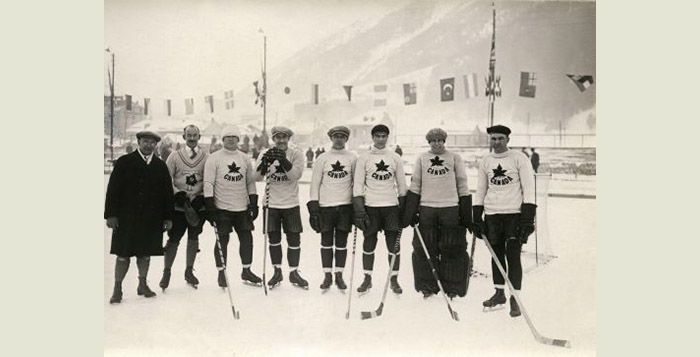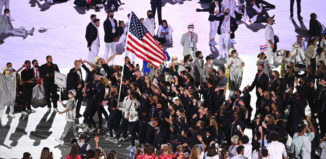This Day in Hockey History – February 3, 1924 – Gold at Chamonix
Toronto Granites (Photo: Nationaal Archief [Public domain], via Wikimedia Commons
Hockey had been added to the 1920 Games of the VIIth Olympiad for the first time when it was actually played in April among the summer sports. The 1st Olympic Winter Games were held at Chamonix, France in 1924, beginning January 25, 1924 and ending on February 5, 1924. In the sport of hockey eight nations competed, split into two groups of four. Group A consisted of Canada, Czechoslovakia, Sweden, and Switzerland. Group B saw Belgium, France, Great Britain and the United States battling. In a round robin within each group, the teams played each other with the top two teams of each advancing to the semi-finals.
At the end of the round-robin, Canada and Sweden advanced from Group A and the United States and Great Britain were the surviving teams from Group B. February 1, 1924 saw Canada—the first place in Group A—take on Great Britain, who was in second place in Group B. Likewise, after that game, the United States, leader of Group B, took on Sweden from Group A. Just as with many of the round-robin games, there were no shortages of goals scored by Canada and the United States in the semi-final round. Canada beat Great Britain 19-2 while the United States scored 20 goals while blanking Sweden.
The Bronze game saw Great Britain squeak out the win over Sweden 4-3. And then later on that day, February 3, 1924, the two nations who would become powerhouses in their own ways, Canada and the United States, would vie for the gold.
The Toronto Granites represented Canada. The team, an offshoot of the Toronto Granite Curling Club—which is still active today—was formed in the 1880s and is recognized as the first organized ice hockey team in Toronto. Their beginnings were exhibition games only with no championships or tournaments. They joined the Ontario Hockey Association in its inaugural season in 1890-91 and would continue to play in the OHA until 1924.
Team USA was made of mostly players from Massachusetts who were playing iAA in Boston. Among them was Clarence “Taffy” Abel who became the first U.S.-born player to become an NHL regular, joining the New York Rangers for the 1926-27 season. Additionally, two players who were born in Canada became naturalized citizens: Herb Drury and Frank Synott.
As described in the February 4, 1924 edition of The Winnipeg Tribune, “Canada reigns supreme in the amateur hockey world. This fact was decided here [Chamonix] yesterday when their merry little band of puck-chasers disposed of the United States team by a six to one score in the final of the Olympic hockey classic.”
The article went on to describe how the Americans seemed more focused on trying to stop the Canadians rather than scoring goals. The game played by the Canadians was called unselfish, pointing out how the team looked for the man who had the shot, passing the puck when necessary.
The Vancouver Daily World described the game as “a fast and furious contest from start to finish, and when the referee blew his whistle and the game was over, the United States players were physically exhausted and stumbling from fatigue.”
Not surprisingly the fans enjoyed the game. “The thousands of spectators watching the most hard-fought and swiftest hockey that Europe had ever seen, thrilled by the desperate stand made by the United States under the pressure of the better co-ordinated Canadian team. Time after time cheers broke from the crowd as Drury or Rice clashed <sic> away for a rush into Canadian territory only to be foiled as he reached [Beattie] Ramsay or [Dunc] Munro,” reported The Winnipeg Tribune.
The Scottish born Munro, who was born in 1901, immigrated to Toronto, Ontario as a small child. He would play two years with the University of Toronto Schools team from the age of 17 to 19. He went on to pay with the Toronto Granites for five years before joining the Montreal Maroons during the 1924-25 season, winning the Stanley Cup that year and remaining with them through the 1930-31 season. He played his last season with the Montreal Canadiens.
Many times since these two teams have found themselves looking at each other over a puck, striving to be the team to show that their system is the best.
Additional Sources:
- “Beat United States in Chamonix Final,” The Winnipeg Tribune, February 4, 1924, p. 10.
- “Canadians Win Olympics Hockey Title, American Puck Team Outclassed,” Vancouver Daily World, February 4, 1924, p. 12.
- IIHF Guide & Record Book 2018, p. 159-60.














